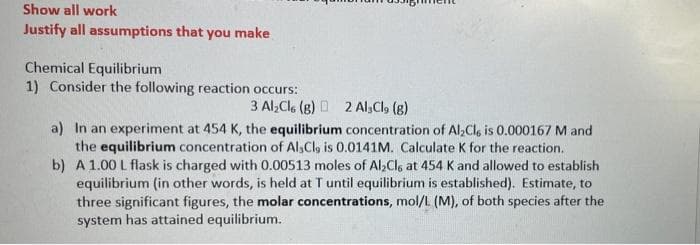Chemical Equilibrium ) Consider the following reaction occurs: 3 Al;Cle (g) D 2 Al,Cl, (g) a) In an experiment at 454 K, the equilibrium concentration of Al;Cl, is 0.000167 M and the equilibrium concentration of Al,Cl, is 0.0141M. Calculate K for the reaction. b) A 1.00 L flask is charged with 0.00513 moles of Al;Cle at 454 K and allowed to establish equilibrium (in other words, is held at T until equilibrium is established). Estimate, to three significant figures, the molar concentrations, mol/L (M), of both species after the system has attained equilibrium.
Chemical Equilibrium ) Consider the following reaction occurs: 3 Al;Cle (g) D 2 Al,Cl, (g) a) In an experiment at 454 K, the equilibrium concentration of Al;Cl, is 0.000167 M and the equilibrium concentration of Al,Cl, is 0.0141M. Calculate K for the reaction. b) A 1.00 L flask is charged with 0.00513 moles of Al;Cle at 454 K and allowed to establish equilibrium (in other words, is held at T until equilibrium is established). Estimate, to three significant figures, the molar concentrations, mol/L (M), of both species after the system has attained equilibrium.
Chemistry for Engineering Students
4th Edition
ISBN:9781337398909
Author:Lawrence S. Brown, Tom Holme
Publisher:Lawrence S. Brown, Tom Holme
Chapter12: Chemical Equilibrium
Section: Chapter Questions
Problem 12.34PAE: 1’he reaction in Exercise 12.33 was repeated. This time, the reaction began when only NO was...
Related questions
Question

Transcribed Image Text:Show all work
Justify all assumptions that you make
Chemical Equilibrium
1) Consider the following reaction occurs:
3 Al,Cle (g) D 2 Al,Cl, (g)
a) In an experiment at 454 K, the equilibrium concentration of Al;Cl, is 0.000167 M and
the equilibrium concentration of Al,Cl, is 0.0141M. Calculate K for the reaction.
b) A 1.00 L flask is charged with 0.00513 moles of Al;Clg at 454 K and allowed to establish
equilibrium (in other words, is held at T until equilibrium is established). Estimate, to
three significant figures, the molar concentrations, mol/L (M), of both species after the
system has attained equilibrium.
Expert Solution
This question has been solved!
Explore an expertly crafted, step-by-step solution for a thorough understanding of key concepts.
Step by step
Solved in 2 steps with 2 images

Knowledge Booster
Learn more about
Need a deep-dive on the concept behind this application? Look no further. Learn more about this topic, chemistry and related others by exploring similar questions and additional content below.Recommended textbooks for you

Chemistry for Engineering Students
Chemistry
ISBN:
9781337398909
Author:
Lawrence S. Brown, Tom Holme
Publisher:
Cengage Learning

Chemistry
Chemistry
ISBN:
9781305957404
Author:
Steven S. Zumdahl, Susan A. Zumdahl, Donald J. DeCoste
Publisher:
Cengage Learning

Chemistry: An Atoms First Approach
Chemistry
ISBN:
9781305079243
Author:
Steven S. Zumdahl, Susan A. Zumdahl
Publisher:
Cengage Learning

Chemistry for Engineering Students
Chemistry
ISBN:
9781337398909
Author:
Lawrence S. Brown, Tom Holme
Publisher:
Cengage Learning

Chemistry
Chemistry
ISBN:
9781305957404
Author:
Steven S. Zumdahl, Susan A. Zumdahl, Donald J. DeCoste
Publisher:
Cengage Learning

Chemistry: An Atoms First Approach
Chemistry
ISBN:
9781305079243
Author:
Steven S. Zumdahl, Susan A. Zumdahl
Publisher:
Cengage Learning


Chemistry: Principles and Reactions
Chemistry
ISBN:
9781305079373
Author:
William L. Masterton, Cecile N. Hurley
Publisher:
Cengage Learning

Chemistry: Principles and Practice
Chemistry
ISBN:
9780534420123
Author:
Daniel L. Reger, Scott R. Goode, David W. Ball, Edward Mercer
Publisher:
Cengage Learning